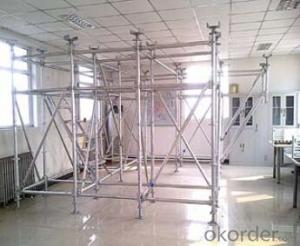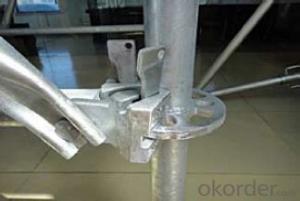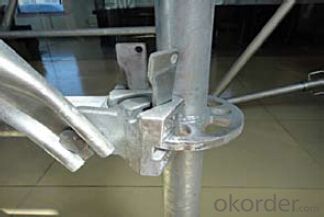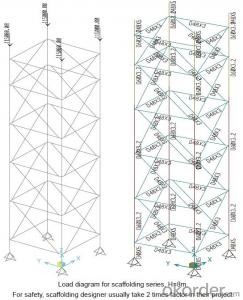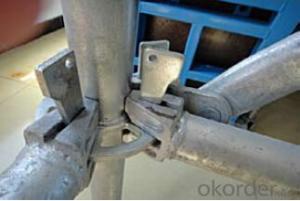Ring-lock Scaffolding Accessories for Formwork and scaffolding System
- Loading Port:
- Tianjin
- Payment Terms:
- TT OR LC
- Min Order Qty:
- 50 m²
- Supply Capability:
- 1000 m²/month
OKorder Service Pledge
Quality Product, Order Online Tracking, Timely Delivery
OKorder Financial Service
Credit Rating, Credit Services, Credit Purchasing
You Might Also Like
Ring-lock Scaffolding
A support system for construction, ownsadvantages of both cup-lock scaffolding andshoring tower.
It is in the development direction of new typescaffolding.
It is widely used in buildings, bridges, tunnels etc..
Characteristics:
◆ Easy to storage and transportation
◆ High degree of standardization
◆ Easy and quick erection
◆ Excellent stability and bearing capacity
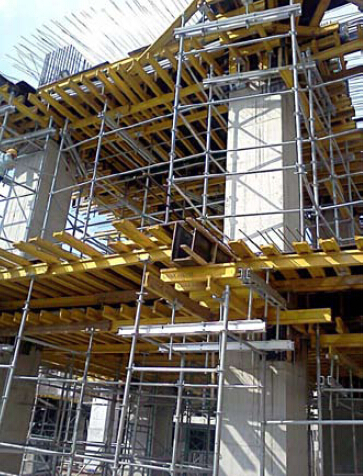
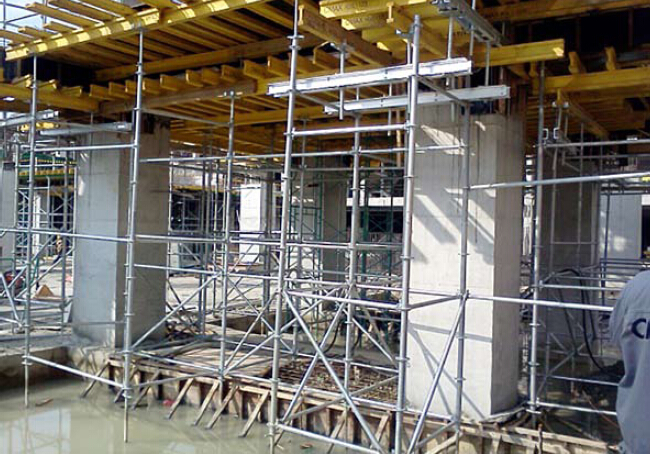
- Q: Can steel formwork be used for elevated walkways?
- Steel formwork is indeed suitable for constructing elevated walkways. It is a highly versatile and durable construction material that can be used for various applications, including the construction of elevated walkways. The strength and stability of steel formwork systems make them ideal for supporting the weight and load of a walkway. By using steel formwork for elevated walkways, one can ensure the creation of a safe and robust structure capable of withstanding heavy foot traffic and adverse weather conditions. Moreover, steel formwork allows for flexibility in design, enabling the construction of customized walkways with different shapes and sizes. In conclusion, steel formwork is a reliable choice for constructing elevated walkways due to its strength, durability, and versatility.
- Q: How does steel formwork handle formwork stripping and repositioning?
- Steel formwork is a highly durable and versatile option for handling formwork stripping and repositioning. It is designed to withstand the pressure exerted during the concrete pouring process and can easily handle the removal of the formwork once the concrete has set. When it comes to formwork stripping, steel formwork offers several advantages. Firstly, it provides a smooth surface finish to the concrete, ensuring a high-quality end result. The steel panels are typically coated with a protective layer, which prevents concrete from sticking to the formwork and facilitates easy stripping. The steel formwork system is engineered to allow for quick and efficient formwork removal. This is achieved through the use of various mechanisms such as wedge clamps, pins, or hooks, which securely hold the formwork panels in place during the pouring process. Once the concrete has achieved sufficient strength, these mechanisms can be easily released, allowing for smooth and effortless stripping of the formwork. Moreover, steel formwork can be easily repositioned and reused for multiple construction projects. The modular design of steel panels allows for flexibility in adjusting the formwork to different dimensions and shapes. This reusability significantly reduces the overall cost of formwork, making it a cost-effective solution for construction projects. Additionally, steel formwork offers excellent strength and stability, ensuring that the structure remains intact during the entire process of formwork stripping and repositioning. This is particularly important in high-rise or complex structures where the formwork needs to withstand significant loads and pressures. In summary, steel formwork is a reliable and efficient choice for handling formwork stripping and repositioning. Its durability, ease of use, and adaptability make it a preferred option for construction projects of various scales and complexities.
- Q: Are there different sizes of steel formwork available?
- Yes, there are different sizes of steel formwork available. Steel formwork is a versatile construction material that is widely used in various building projects. It offers strength, durability, and stability, making it suitable for various applications. Steel formwork can be customized to different sizes based on specific project requirements. This allows for flexibility in creating different shapes and structures. Additionally, the use of steel formwork enables efficient construction processes, as it can be easily assembled and disassembled, making it suitable for both small and large-scale projects.
- Q: How does steel formwork prevent concrete shrinkage and cracking?
- Steel formwork prevents concrete shrinkage and cracking by providing a rigid and stable structure that holds the concrete in place during the curing process. This helps to minimize the risk of shrinkage and cracking by providing support and preventing excessive movement of the concrete as it dries and hardens. Additionally, steel formwork allows for proper compaction of the concrete, ensuring that it is evenly distributed and reducing the likelihood of shrinkage and cracking.
- Q: How does steel formwork handle concrete shrinkage and expansion?
- Steel formwork is a versatile and durable option for handling concrete shrinkage and expansion. One of the key advantages of using steel formwork is its ability to withstand the forces exerted by the concrete during shrinkage and expansion. Concrete shrinkage occurs as the water in the mixture evaporates, causing the concrete to contract. Steel formwork is well-suited to handle this shrinkage because it provides a rigid structure that can resist the inward force exerted by the contracting concrete. The steel panels and beams used in steel formwork are robust and can maintain their shape under the pressure, ensuring that the formwork remains intact even as the concrete shrinks. On the other hand, concrete expansion can occur due to various factors such as temperature changes or moisture absorption. Steel formwork is designed to accommodate this expansion by incorporating expansion joints. These joints allow the concrete to expand and contract without causing any damage to the formwork. The joints can be easily adjusted to accommodate the expansion, ensuring that the formwork remains stable and secure. In addition to its strength and flexibility, steel formwork also offers other benefits when it comes to handling concrete shrinkage and expansion. It is highly reusable, which means that it can be dismantled and reassembled for use in multiple projects. This not only reduces the overall cost of construction but also allows for easy adjustments to be made in case any changes are required due to concrete shrinkage or expansion. Furthermore, steel formwork provides a smooth and even surface finish to the concrete, minimizing the chances of cracking or unevenness caused by shrinkage. This ensures that the final concrete structure is of high quality and meets the desired specifications. In summary, steel formwork is a reliable and effective solution for handling concrete shrinkage and expansion. Its strength, flexibility, and ability to accommodate these forces make it a preferred choice for construction projects. By using steel formwork, builders can ensure that their concrete structures remain stable, durable, and free from any damage caused by shrinkage or expansion.
- Q: Can steel formwork be used for precast concrete slabs?
- Precast concrete slabs can indeed utilize steel formwork. A prevalent technique in precast construction involves employing steel formwork to create the molds or formwork for pouring concrete. Steel formwork boasts several advantages over other materials used for formwork, including its high durability, reusability, and superior strength. Its rigid and stable structure enables it to withstand the weight and pressure exerted by the concrete during the casting process. Moreover, steel formwork facilitates precise shaping and finishing of concrete slabs, ensuring a consistent and high-quality end product. Its assembly and disassembly are straightforward, making it suitable for repetitive use in precast concrete production. Furthermore, steel formwork can be tailored and customized to meet specific project requirements, encompassing various sizes, shapes, and patterns for the concrete slabs. Nevertheless, it is crucial to consider the cost and maintenance of steel formwork, which can be pricier in comparison to materials like wood or plastic. Regular maintenance and cleaning are essential to ensure the longevity and efficiency of steel formwork. Overall, steel formwork stands as a dependable and widely utilized option for creating molds for precast concrete slabs, offering numerous benefits in terms of strength, durability, and customization options.
- Q: What are the different types of reinforcements used in steel formwork?
- There are several types of reinforcements used in steel formwork, each with their own unique characteristics and benefits. 1. Steel bars: The most commonly used reinforcement in steel formwork is steel bars, also known as rebars. These bars are made of carbon steel and are available in various sizes and shapes. They provide strength and stability to the formwork structure, ensuring its ability to withstand the load and pressure during concrete pouring. 2. Steel mesh: Steel mesh is another type of reinforcement used in steel formwork. It consists of interconnected steel wires arranged in a grid pattern. Steel mesh provides added strength and prevents cracking or failure of the concrete due to shrinkage or temperature changes. It is commonly used in large-scale construction projects where large areas need to be reinforced. 3. Steel fibers: Steel fibers are small, discrete lengths of steel that are added to the concrete mix to enhance its structural properties. These fibers improve the tensile strength and ductility of the concrete, reducing the need for additional reinforcement. Steel fibers are especially beneficial in areas where heavy loads or dynamic forces are expected, such as industrial floors or pavements. 4. Steel plates: Steel plates are flat, rectangular sheets made of steel that are used to reinforce specific areas of the formwork. They are often used to reinforce corners, joints, or areas that require extra support. Steel plates are versatile and can be easily customized to fit the desired shape or size. 5. Steel beams: Steel beams are structural elements used to support the formwork and distribute the loads evenly. They provide stability and rigidity to the formwork structure, ensuring its integrity during the concrete pouring process. Steel beams are available in various shapes and sizes, including I-beams, H-beams, and U-beams, depending on the specific requirements of the project. Overall, the use of different types of reinforcements in steel formwork ensures the strength, durability, and stability of the structure. The choice of reinforcement depends on factors such as the load-bearing capacity, expected forces, and the specific requirements of the project.
- Q: How does steel formwork prevent concrete segregation?
- Steel formwork helps prevent concrete segregation by providing a rigid and stable structure for the concrete to be poured into. Unlike other types of formwork materials such as wood or plastic, steel formwork maintains its shape and prevents any movement or deformation during the pouring and curing process. Concrete segregation occurs when the different components of concrete, such as cement, aggregates, and water, separate from each other, resulting in an uneven distribution of these components within the mixture. This can weaken the concrete structure and lead to various issues such as reduced strength, cracking, or voids. Steel formwork prevents concrete segregation by offering a smooth and even surface for the concrete to be poured onto. The rigid nature of steel ensures that there are no gaps or spaces for the components of the concrete to separate or settle unevenly. This helps to maintain a consistent and uniform distribution of the cement, aggregates, and water throughout the entire concrete mixture. Additionally, steel formwork provides a tight seal against the sides and bottom of the form, preventing any leakage or loss of moisture during the curing process. This helps in maintaining the required water-cement ratio, which is crucial for the proper hydration and hardening of the concrete. By preventing excessive evaporation or moisture loss, steel formwork ensures that the concrete cures evenly, reducing the chances of segregation. Furthermore, the use of steel formwork allows for precise and accurate placement of the concrete, eliminating any potential gaps or voids that could contribute to segregation. The steel formwork can be designed with various features such as tie rods, clamps, or connectors to hold the formwork panels securely in place, ensuring that the concrete is poured and compacted uniformly. In summary, steel formwork prevents concrete segregation by providing a stable and rigid structure that maintains the shape and integrity of the concrete mixture. It prevents the separation of components, ensures a consistent distribution of materials, and allows for precise and accurate placement of the concrete, resulting in a stronger and more durable structure.
- Q: How does steel formwork affect the aesthetics of a building?
- The aesthetics of a building can be significantly impacted by steel formwork in various ways. Firstly, steel formwork allows for the creation of complex and intricate designs, resulting in visually appealing architectural elements. The flexibility and strength of steel enable the construction of unique shapes, curves, and patterns that enhance the overall aesthetics of the building. Moreover, steel formwork gives concrete surfaces a smooth and seamless finish. This contributes to a more refined and polished appearance, especially when compared to other formwork materials like timber or plastic. The absence of visible joints, seams, or imperfections on the concrete surfaces enhances the overall look of the building. Additionally, steel formwork offers the advantage of reusability, leading to cost savings and reduced waste. This economic benefit allows architects and designers to allocate more resources to enhance the building's aesthetics, such as incorporating high-end finishes or unique decorative elements. Furthermore, steel formwork ensures a high level of accuracy and precision during the construction process. This precision guarantees that the final structure is aligned and symmetrical, enhancing the overall visual harmony of the building. Straight lines, sharp corners, and consistent dimensions can be achieved with steel formwork, resulting in a visually pleasing and harmonious architectural design. Lastly, the durability and strength of steel formwork contribute to the long-term aesthetics of the building. Steel formwork can withstand harsh weather conditions, resist corrosion, and maintain its structural integrity over time. This durability ensures that the building's aesthetics remain intact for an extended period, enhancing its overall appeal and value. To conclude, steel formwork has a positive impact on the aesthetics of a building by enabling complex designs, providing a smooth finish, allowing for precision and accuracy, offering cost savings, and ensuring long-lasting visual appeal.
- Q: Can steel formwork be used in architectural concrete projects?
- Yes, steel formwork can be used in architectural concrete projects. Steel formwork is a common choice for many construction projects, including architectural concrete, due to its durability, strength, and versatility. Steel formwork provides excellent support and stability to the concrete structure, ensuring that it maintains its desired shape and form during the pouring and curing process. Additionally, steel formwork is highly resistant to warping or bending under the weight and pressure of the concrete, which is crucial for achieving accurate and precise architectural designs. Steel formwork also allows for easy assembly and dismantling, making it a cost-effective option for architectural concrete projects. Overall, steel formwork is a reliable and efficient choice for architects and builders looking to create intricate and aesthetically pleasing concrete structures.
Send your message to us
Ring-lock Scaffolding Accessories for Formwork and scaffolding System
- Loading Port:
- Tianjin
- Payment Terms:
- TT OR LC
- Min Order Qty:
- 50 m²
- Supply Capability:
- 1000 m²/month
OKorder Service Pledge
Quality Product, Order Online Tracking, Timely Delivery
OKorder Financial Service
Credit Rating, Credit Services, Credit Purchasing
Similar products
Hot products
Hot Searches
Related keywords
